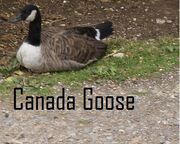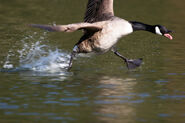
Canada goose - WWC Archives
The Canada Goose, (Branta canadensis), was introduced from America to Britain in the 17th century. Since the 17th century, it has increased in population and habitat distribution. They populate park ponds and other water bodies. It was once attempted to breed these birds for shooting, but their low flight, tame nature and irregular flying times made it impossible. Its nest is made of plant material by the water's edge. Up to five eggs are laid and the young goslings are able to fly after they are 9 weeks old. They stay with their parents until the following spring.
Description[]
The black head and neck with white "chinstrap" distinguish the Canada Goose from all other goose species, with the exception of the Barnacle Goose, but the latter has a black breast, and also grey, rather than brownish, body plumage.
This species is 76–110 centimetres (30–43 in) long with a 127–180 centimetres (50–71 in) wingspan. The male usually weighs 3.2–6.5 kilograms (7.1–14 lb), and can be very aggressive in defending territory. The female looks virtually identical but is slightly lighter at 2.5–5.5 kilograms (5.5–12 lb), generally 10% smaller than its male counterpart, and has a different honk.
Distribution and habitat[]
This species is native to North America. It breeds in Canada and the northern United States in a variety of habitats. Its nest is usually located in an elevated area near water such as streams, lakes, ponds and sometimes on a beaver lodge. Its eggs are laid in a shallow depression lined with plant material and down. The Great Lakes region maintains a very large population of Canada Geese.
Outside North America[]
Canada Geese have reached northern Europe naturally, as has been proved by ringing recoveries.
Greater Canada Geese have also been introduced in Europe, and have established populations in Great Britain, the Netherlands, Belgium, Germany, and Scandinavia. Semi-tame feral birds are common in parks, and have become a pest in some areas. In the early 17th century, explorer Samuel de Champlain sent several pairs of geese to France as a present for King Louis XIII. The geese were first introduced in Britain in the late 17th century as an addition to King James II's waterfowl collection in St. James's Park.
Behavior[]
Like most geese, the Canada Goose is naturally migratory. The calls overhead from large groups of Canada Geese flying in V-shaped formation signal the transitions into spring and autumn. In some areas, migration routes have changed due to changes in habitat and food sources.
Diet[]
Canada Geese are primarily herbivores, although they sometimes eat small insects and fish.[1]Their diet includes green vegetation and grains. The Canada Goose eats a variety of grasses when on land. It feeds by grasping a blade of grass with the bill, then tearing it with a jerk of the head. The Canada Goose also eats grains such as wheat, beans, rice, and corn when they are available. In the water, it feeds from silt at the bottom of the body of water. It also feeds on aquatic plants, such as seaweeds. In urban cities, they are also known to pick food out of rubbish bins.
Reproduction[]
During the second year of their lives, Canada Geese find a mate. They are monogamous, and most couples stay together all of their lives. If one is killed, the other may find a new mate. The female lays 3–8 eggs and both parents protect the nest while the eggs incubate, but the female spends more time at the nest than the male.
During this incubation period, the adults lose their flight feathers, so they cannot fly until their eggs hatch after 25–28 days.
Adult geese are often seen leading their goslings in a line, usually with one parent at the front, and the other at the back. While protecting their goslings, parents often violently chase away nearby creatures, from small blackbirds to humans that approach, after warning them by giving off a hissing sound. Most of the species that prey on eggs will also take a gosling. Although parents are hostile to unfamiliar geese, they may form groups of a number of goslings and a few adults, called crèches.
The offspring enter the fledging stage any time from 6 to 9 weeks of age. They do not leave their parents until after the spring migration, when they return to their birthplace. Once they reach adulthood, Canada Geese are rarely preyed on, but (beyond humans) can be taken by Red Foxes, Golden Eagles and, other predators.








